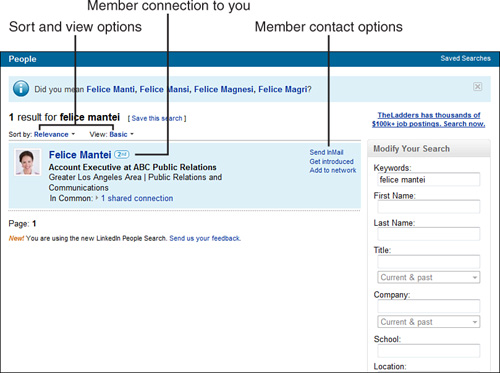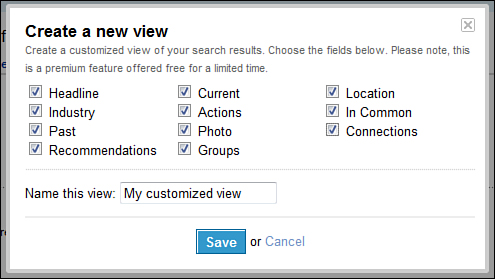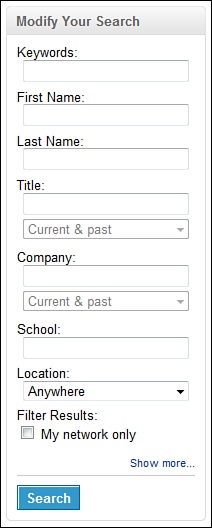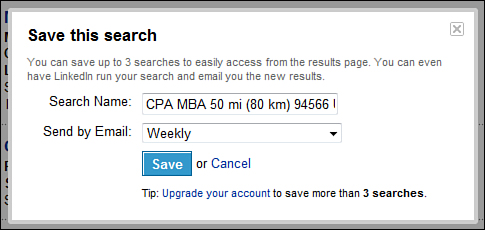In this lesson, you’ll learn about LinkedIn quick searches, searching for people, and advanced search techniques.
LinkedIn is a large, complex network of information. You can greatly improve your chances of achieving your networking goals by learning how to find exactly what you want among 40 million member profiles and many more millions of answers, job postings, and group discussions. The easiest way to search for information on LinkedIn is to use the search box on LinkedIn’s top navigation menu, shown in Figure 7.1.
To perform a quick search, follow these steps:
- Select the focus of your search from the drop-down list. Options include
• Search People (the default)
• Search Jobs
• Search Companies
• Search Answers
• Search Inbox
• Search Groups
- Enter your search term in the text box. This might be a person’s name, company name, job title, job skill, or a keyword, for example.
- Click the Search button. LinkedIn displays search results. The format of the search results depends on the type of search you perform.
This lesson focuses on LinkedIn’s most popular search type (the people search) and advanced search techniques. To learn more about searching for jobs, companies, answers, your inbox, and groups, refer to the lessons in this book that cover those topics.
The fastest way to search for people is to perform a quick search from the search box on LinkedIn’s top navigation menu. For example, let’s say that you’re searching for your former colleague Felice Mantei. Enter her name in the search box and click the Search button. Your search results appear, shown in Figure 7.2.
Note: LinkedIn Helps You Find Matches as You Type
As you type, LinkedIn displays a drop-down list of potential matches in your network of connections. If you see a match in this list, click the member’s name to open that member’s profile.
Each LinkedIn member who matches your search results appears in a preview box that includes a photo, name, headline, location, industry, and information about shared connections and groups. Depending on the preview you’re viewing, not all items might appear. For example, a member might choose not to upload a photo.
Icons appear to the right of each member’s name indicating their connection to you, such as a 1st degree connection, 2nd degree connection, 3rd degree connection, or group member. For members who are out of your network, you may view the Out of Network designation next to their name or their name may be hidden from view.
See Lesson 6, “Communicating with Other LinkedIn Members,” for a reminder of how LinkedIn classifies its members.
Hover over the preview of a specific LinkedIn member to view the available contact links (the preview box turns blue). Possible links include Send Message, Get Introduced, Send InMail, or Add to Network. The options available depend on your connection to the particular member. For example, it wouldn’t make sense for you to send InMail or get introduced to someone you already connect with. See Lesson 6, “Communicating with Other LinkedIn Members,” for more information about the available options for contacting others on LinkedIn.
When you search for the name of a specific individual, the search results should display a short list (unless the individual has a very common name). But what if you can’t remember someone’s last name or you’re searching for LinkedIn members who meet specific criteria such CPAs in the Indianapolis area? In this case, your search might return thousands of results, exceeding the 100-result viewing limits associated with a personal account.
There are two ways to handle this. One is to narrow the results that display on your search results page. The other is to perform an advanced search that targets very specific criteria.
On the search results page, you can sort the search results using the following criteria:
• Relevance. Displays search results in the order LinkedIn determines most appropriate based on keywords you enter and your network.
• Relationship. Displays search results based on their position in your network, in the following order: 1st degree connections, 2nd degree connections, fellow group members, and 3rd degree connections that are combined with out-of-network connections.
• Relationship + Recommendation. Displays search results by relationship. Those that have the most recommendations are listed first for each relationship category.
• Keyword. Displays search results that match your keywords without considering their placement in your network.
You can also customize the member information you preview in your search results. The options are
• Basic. Displays a photo, name, professional headline, location, industry, and details about shared connections.
• Expanded. Displays all the information from the basic view and current and past employment details.
• Create a New View. Opens the Create a New View pop-up box (see Figure 7.3) in which you can specify the exact information you want to display in the preview. Options include the data you can see in Basic and Expanded views and Recommendations, Groups, and number of Connections. Click the Save button to save your customized view for future use. Customized views are a premium feature for customers who upgrade to a paid account.
You can narrow your search results in the Modify Your Search box on the right side of your screen, shown in Figure 7.4.
In this box, you can narrow your search results by specifying any of the following criteria:
• Keywords. Enter a keyword that LinkedIn searches for in member profiles. The best keywords are terms that don’t fit any of the other search criteria and are specific words that a member might include on a profile. For example, entering a name or location wouldn’t be appropriate here, but terms such as Java, PMP, auditing, CPA, and so forth would work well.
• First Name. Enter the first name of the member you want to find.
• Last Name. Enter the last name of the member you want to find.
• Title. Enter a job title and specify in the drop-down list whether you want to search only for members who hold this title currently, in the past, or both currently and in the past.
• Company. Enter a company name and specify in the drop-down list whether you want to search only for members who work at this company currently, in the past, or both currently and in the past.
• School. Enter the name of a college or university.
• Location. Select a Country, Postal Code, and distance range.
• My Network Only. Select this check box if you want to search only within your network.
Click the Search button to update the search results.
To view even more search options, click the Show More link, which provides you with these additional options:
• Industry. Select the industries you want to include in your search.
• Groups. Select the groups you want to include in your search. Your choices include only those groups you currently belong to. If you don’t belong to any groups, you won’t see this option.
• Language. Select the languages in which you want to view profiles.
• Interested In. Select one of the following options: all users, potential employees, consultants/contractors, entrepreneurs, hiring managers, industry experts, or deal-making contacts. LinkedIn displays members who are potential matches based on their profile content.
• Joined. Select one of the following options: at any time, since your last login, in the last day, in the last week, in the last two weeks, in the last month, or in the last three months. Recruiters, for example, might use this option to receive notifications of new members who match the recruiters’ job search criteria.
Again, click the Search button to update results.
If you want to search for very specific criteria, you can perform an advanced people search. An advanced search offers you the same options as the extended version of the Modify Your Search box on the search results page, but you can perform it all in one step. For example, you might enter a search term in the quick search box and then decide to narrow your results. But if you already know that you want to search for specific keywords, companies, or locations, for example, an advanced search is a more streamlined option.
To perform an advanced people search, select the Search People option (if it’s not already selected by default) on the search box that appears on the top navigation menu and click the Advanced link. Figure 7.5 shows the Advanced Search page.
Figure 7.5. LinkedIn’s advanced search options provide maximum flexibility in finding members who meet specific criteria.
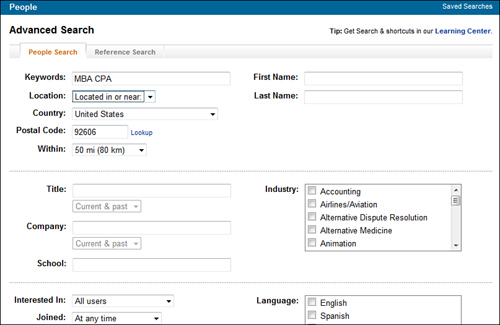
Enter your search criteria on this page and click the Search button to display your search results. Refer to “Narrowing People Search Results,” earlier in this lesson for descriptions of each field on this page.
Note: Performing a Reference Search
The Advanced Search page also includes a Reference Search tab in which you can search for potential references for a job candidate. See Web Lesson 1, “Recruiting Job Candidates,” for more information about reference searches.
If you perform the same searches frequently, saving them can reduce redundant data entry. To save a search for future use, follow these steps:
- Click the Save This Search link on the search results page.
- In the Save This Search pop-up box, enter a Search Name for this search (see Figure 7.6).
- In the Send by Email field, choose to receive email updates of your search results: Weekly, Monthly, or Never. You don’t have to receive updates by email, but this can be a timesaver if you’re very interested in following updates to your saved search. For example, recruiters might want to know about new LinkedIn members who match specific search criteria. Or job seekers might want to know about new LinkedIn members who work at companies they’re interested in working for.
Note: LinkedIn Limits the Number of Searches You Can Save
As a free personal account holder, you can save up to three searches and receive email updates either weekly or monthly. To save more searches, click the Upgrade Your Account link to sign up for a premium account. If you want to receive daily email updates on your saved searches, you must select the Pro account option.
- Click the Save button to save your search.
To edit or delete your saved searches, click the Save Searches link in the upper-right corner of the search results page.
LinkedIn offers several techniques for narrowing your search results even further. You can use these techniques when performing a quick search or when using the Advanced Search page. For example, you can search for phrases in quotation marks, use search operators such as NOT and OR, or enter complex criteria with a parenthetical search.
LinkedIn enables you to use specific search operators to define advanced criteria directly in the quick search box. For example, ccompany is the operator for current company and title is the operator for job title. Entering ccompany:Google title:director would quickly list all current Google employees with the title of director.
For more information about advanced search techniques, visit the LinkedIn Learning Center at http://learn.linkedin.com/linkedin-search. Scroll down the page to the “Advanced Search Tips” section.

